Can you eat fruit on a ketogenic diet? In short, it’s best to avoid most fruits except for berries, avocados, olives, and tomatoes, which you can eat in moderation. Below, we’ll take a closer look at some of the best keto fruits you can eat on a low carb diet and what you should avoid.
When people switch to a ketogenic diet, fruit can be an area of confusion. Fruit has been marketed as healthy for many years and generally has a positive stigma behind it.
On the ketogenic diet, however, fruit consumption can make it difficult to keep our carbs restricted below 30g per day so we can enter ketosis. In most cases, just one piece of fruit will make up the majority of our daily carb intake on keto.
Since fruits are packed with natural sugars (fructose and glucose), we have to carefully watch the amount of low carb fruit we eat each day. The best strategy to minimize fruit sugar intake is to stick with berries (notably raspberries and blackberries), avocados, olives, and tomatoes as our fruits of choice on the ketogenic diet. It is also a good idea to avoid any medium and large sized fruits as they tend to have too many sugars for ketosis.
To learn more about low-carb fruits and how to include them on keto, continue reading below. On the other hand, If you have specific concerns about other food categories and what foods are keto-friendly, check out our in-depth keto food list.
Common Fruit and Their Carb Counts
If you’re on a low-carb, ketogenic diet and want to indulge in some fruit occasionally, that’s no problem at all. Try to stick with berries and lower carb fruit that can fit within your macro ranges. Remember that you want to stick to 30g or less of carbohydrate intake per day to help stimulate and sustain ketosis.
Although some people argue that you have to eat fruit to be healthy, this is not the case. You can easily get any nutrient from vegetables that you can from fruits, except with a significantly lower amount of sugar and more fiber.
Since the ketogenic diet allows for a good amount of vegetables to be eaten, you won’t be missing out on any health benefits by decreasing your fruit intake. While a sweet treat may be desired once in a while, there really is no need for it.
To help you figure out what fruits you can fit into your keto diet, we created the following chart which has some of the lowest carb fruits, their respective net carb counts per 100g, and the average size of that serving.
Each listing pertains to the fresh, raw variety of the fruit. The nutrition information for processed, packaged, cooked, and/or dried fruit products will vary from what is found in the chart.
Below the chart, you will find a more in-depth explanation of each fruit and some ideas on which fruit to avoid completely. At the bottom, you can find a visual list of all common fruits and their respective carb counts per serving.
Note: Always be careful about fruit added into prepared items. Fruit juice, canned fruits, and fruit snacks tend to have added sugar and are not considered keto friendly. Always check food labels before purchasing items. Fresh or frozen raw fruit with no other added ingredients is always the better option for the keto diet and overall health.
| Fruit Type | Net Carbs (per 100g) | Serving Equivalent |
| Avocado | 1.84 | About half a medium avocado |
| Tomato | 2.69 | One small vine tomato |
| Rhubarb | 2.74 | About 2 full stalks |
| Black Olives | 3.10 | Approximately 25 large black olives |
| Starfruit | 3.93 | About one medium |
| Blackberry | 4.90 | About 3/4 cup |
| Raspberry | 5.44 | About 3/4 cup |
| Strawberry | 5.68 | About 3/4 cup, whole |
| Casaba Melon | 5.70 | Around ⅔ cup, cubed |
| Coconut Meat | 6.23 | About 1 cup, shredded |
| Lemon | 6.52 | About 2 lemons |
| Watermelon | 7.15 | About 8 watermelon balls |
| Cranberry | 7.60 | About 1 cup, whole |
| Cantaloupe | 7.90 | About 7 cantaloupe balls |
| Honeydew Melon | 8.30 | About 8 honeydew balls |
| Peach | 8.40 | About 3/4 small peach |
| Apricot | 9.12 | About 3 apricots, pitted |
| Plum | 10.02 | About 1 1/2 plums |
| Clementine | 10.32 | About 1 medium |
| Granny Smith Apple (with skin) | 11.20 | About 3/5 medium apple |
| Kiwi | 11.66 | About 1 1/2 kiwis |
| Blueberry | 12.09 | About 3/4 cup |
Note: Most other fruits that are not listed in this table should be avoided because their sugar content is too high. Always remember to check nutrition information prior to consuming fruits. The fruit sugars can add up quickly and cause a halt in your weight loss progress.
Below, you’ll see a visual representation of the table. Feel free to save it, share it, and use it as needed! Keep scrolling down to read about the carb counts of the most commonly used fruits and their respective health benefits.

The Three Best Fruits for the Keto Diet
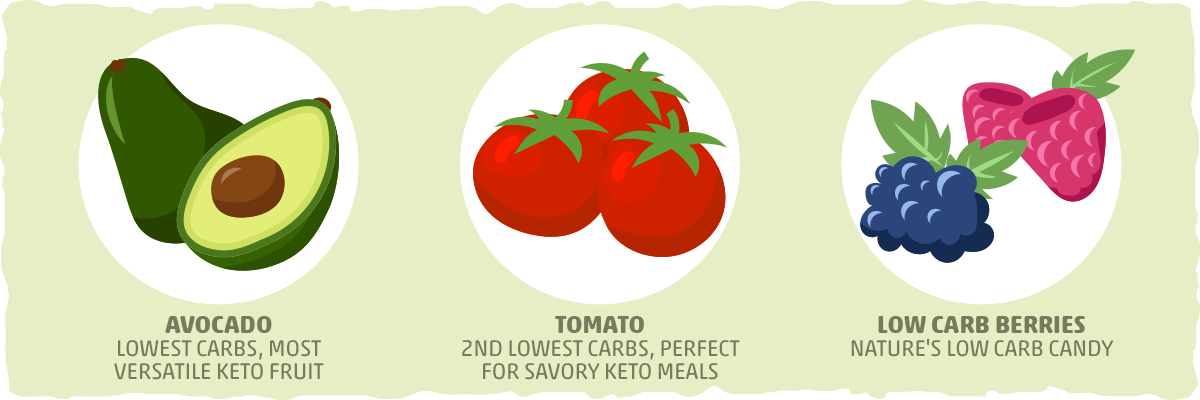
Though you’ll find dozens of low-carb fruits you can incorporate into your keto lifestyle, there are three in particular that we’ve found to be the absolute best for keto:
1. Avocado: The Lowest Carb, Most Versatile Keto Fruit
Being very low in carbs and packed with healthy fats, fiber, and electrolytes, avocado is a nutritional powerhouse of a keto-friendly fruit.
It is also one of the most versatile fruits for the keto diet. For example, you can use avocado to add a velvety texture to keto ice cream, provide a satisfying fudginess to low carb brownies, or turn it into an edible bowl for delicious savory toppings, among others.
2. Tomato: The 2nd Lowest Carb Fruit & Perfect for Savory Keto Meals
Tomatoes are a keto staple for many savory recipes. They are the perfect base for keto sauces and soups and can be eaten roasted, sun-dried, or raw with other keto foods.
This keto fruit is also a great source of vitamin C, potassium, folate, vitamin K, and the antioxidant lycopene, which has been linked to a reduced risk of heart disease and cancer.
3. Low Carb Berries: Nature’s Low Carb Candy
By “low carb berries”, I mean blackberries, raspberries, and strawberries. Though these are a bit higher in carbs than avocados and tomatoes, a small portion is all it takes to boost the flavor and antioxidant content of your favorite keto-friendly breakfast or dessert.
When incorporating them into your meals, make sure you consider their carb counts in the context of your daily keto carb limit. (Just ¾ of a cup can add 5-6 grams of net carbs to your daily carbs.)
Carbs in Raspberries
Raspberries are one of the go-to berries for most people on a low carb diet. They’re low in carbs, high in nutrients, and can be incorporated into both savory and sweet recipes quite easily.
Berries, in general, are well known for their antioxidants which may protect from free radical damage and help fight inflammation. There have even been studies linking berries to lower cholesterol levels and a reduction in heart disease.
Raspberries, in particular, have a high polyphenol content, which can help reduce blood pressure and prevent plaque buildup in the arteries.
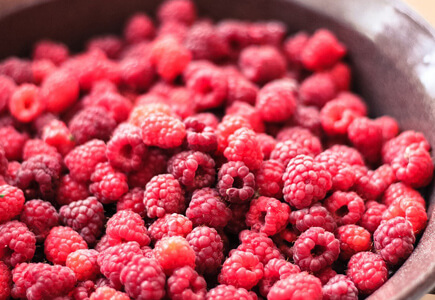
About half a cup of raspberries contains only 3.5g net carbs, so they can be consumed in moderation on a ketogenic diet.
If you want to incorporate more raspberries into your keto diet, give these keto-friendly recipes a try:
Carbs in Blackberries
Blackberries have been used for hundreds of thousands of years for their sweetness and medicinal properties. While they are widely known as a delicious dessert ingredient, they have several surprising health benefits as well.
Blackberries are loaded with vitamin C, K, and manganese which can help with brain and motor function, promote healthier skin, and reduce inflammation. They contain high amounts of ellagic acid and anthocyanin, which have been shown to help suppress cell mutation and slow the growth of cancer.
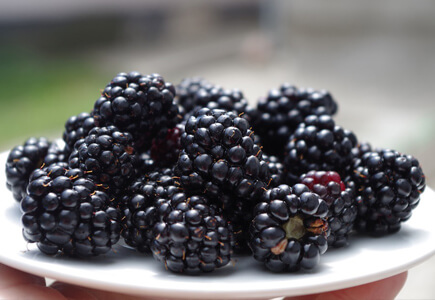
With all of these benefits, it’s not surprising that Romans and Greeks have used this berry and its leaves to treat gout and other health conditions.
It’s also worth noting that blackberries are fibrous like raspberries, containing 8g of fiber (and 7g net carbs) per 1 cup serving. This means that they can help curb cravings and improve gut health.
Want to add some blackberries into your keto diet? Give these keto recipes a try:
- Blackberry, Basil and Spinach Pressed Halloumi
- Blackberry Chipotle Chicken Wings
- Lemon Poppy Seed Cake with Blackberry Buttercream
Carbs in Strawberries
When summer rolls around, the first thing that pops into my head is making some strawberry lemonade popsicles. Strawberries can be extremely refreshing!
As with all berries, strawberries share many of the health benefits that the other berries have.
Strawberries have also been found to improve blood sugar levels, reduce insulin levels, increase insulin sensitivity when compared to groups that did not consume berries. This suggests that the combination of consuming strawberries and following the keto diet may have particularly profound effects for those with type 2 diabetes and insulin resistance.
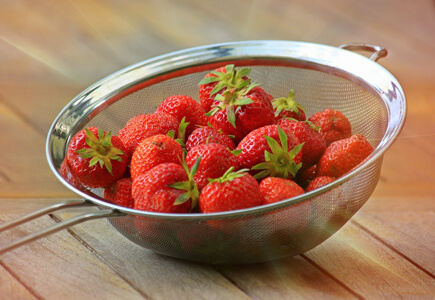
At around 5.5 grams of net carbs per 3/4 cup (100g) serving, strawberries should be consumed in moderation on the keto diet. As long as you are being diligent with the net carbs you consume, you can easily fit some strawberries into your diet without impairing your progress.
If you’d like to try some keto-friendly strawberry recipes, check out these delicious keto desserts:
Carbs in Blueberries
Like the other berries, blueberries are densely packed with antioxidants and vitamin C, which can help promote healthy skin, cognitive function, and overall health. In some studies, blueberries were even shown to have an antiviral effect on skin infections.
Blueberries have the highest amount of carbs out of all the most commonly consumed berries, totaling at 17.8g net carbs in every 1 cup serving. Since they have double the net carbs as strawberries, it is best to limit your blueberry consumption.
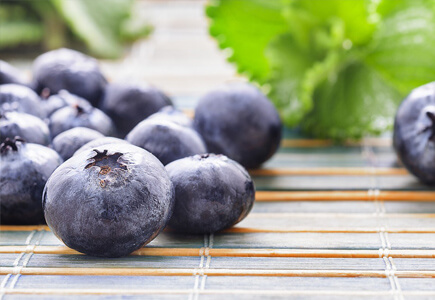
To give you an idea of how you can incorporate blueberries in a keto-friendly way, check out these keto recipes:
If necessary, you can substitute raspberries or blackberries in place of blueberries to minimize your carb intake from these recipes.
Carbs in Avocados
Avocados are a common keto favorite due to their high fat, low protein, and low carb content. They’re loaded with fiber and other important nutrients and are super convenient.
Studies show that avocados improve heart disease risk factors and lower cholesterol.
Their high monounsaturated fat (healthy fat) content is also linked to reduced inflammation and improved insulin sensitivity.
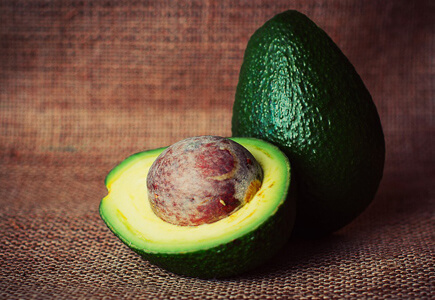
Avocados can also help you get the most out of your low-carb vegetables and berries because they can dramatically increase the quantity of fat-soluble antioxidants you can absorb from these plant foods. They even have more potassium than a banana, so if you’re experiencing the keto flu, an avocado with salt sprinkled on top can really help!
With roughly 4g net carbs per avocado and well over 75% calories from fat, they are a great keto-friendly fruit. They are also extremely versatile, providing the perfect texture for creamy keto desserts and serving as the perfect topping for keto salads.
Take a look at these keto recipes for some avocado inspiration:
Carbs in Tomatoes
While sometimes referred to as a vegetable, tomatoes are pretty important to mention here. They are commonly consumed on a ketogenic diet in the form of sauces or added as a flavor enhancer in many recipes.
They do contain many micronutrients and essential vitamins, but they are most commonly used for their acidic properties.
Tomatoes can add up in carbs quickly, so make sure to use them sparingly and as a flavor enhancer only.
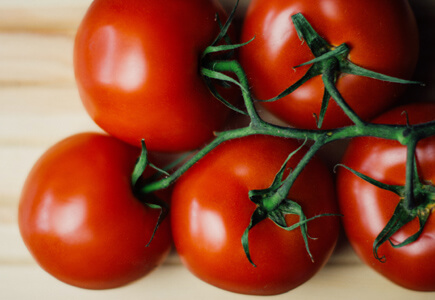
Low-carb tomato sauces are popping up on the shelves now, so make sure to double check nutrition labels before buying. You can also make it yourself with the help of our keto tomato sauce recipe.
If you are following a nightshade-free lifestyle, you can use vinegar and mashed, cooked zucchini to replicate the taste and some of the texture that tomatoes have.
Carbs in Starfruit
While starfruit is not as commonly eaten, it’s a fantastic fruit if you’re missing out on texture. I like to describe it as a mix between a grape and an apple. It’s somewhat softer in texture but offers a sweet and sour flavor.
At only 4g net carbs per 100g, it’s a great fruit to keep in your rotation and use when you’d like a fresh and sweet treat. It also has a good amount of fiber for the size, high amounts of vitamin C, and plant compounds that have been shown to prevent fat cell formation and reduce fatty liver and cholesterol in animal studies.
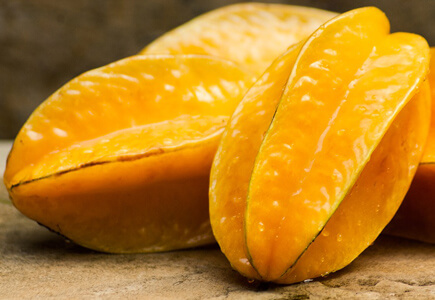
Starfruit is also known as carambola, so keep an eye out when you are looking in the store. It’s got a distinct, star shape to it.
Carbs in Melon
Melon doesn’t usually come to mind when you think of low carb fruits, but they do contain surprisingly low carb counts and can be consumed in moderation.
Here are the carb counts of the four melons with the least amount of sugars:
- Casaba Melon — 5.7g net carbs per 100g
- Watermelon – 7.15g net carbs per 100g
- Cantaloupe – 7.9g net carbs per 100g
- Honeydew Melon – 8.3g net carbs per 100g
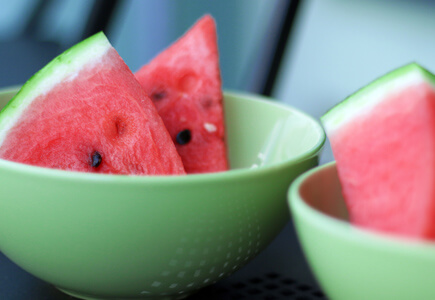
You can usually include some melon in your ketogenic diet, but as with other fruits, you should always be mindful of how much you consume. Use a kitchen scale to measure, check the net carb content, and don’t over consume fruits when they are not needed.
If you need a refreshing treat in the hot summer months, a little bit of watermelon could be a good idea as long as you can stay within your carb limit for the day.
Carbs in Apples
While there are many types of apples to choose from, they generally all should be avoided on keto because of their high sugar content. Granny Smith apples have the highest content of compounds to help prevent disorders associated with obesity and the least sugar of any apple variety, making them the healthiest apple variety.
Unfortunately, they still come in at around 11g net carb per 100g serving (about 3/5 an apple), making them a difficult fruit to fit into the keto diet. Gala, Golden/Red Delicious, Liberty, and Fuji aren’t any better, containing about 11.5g per 100g serving.
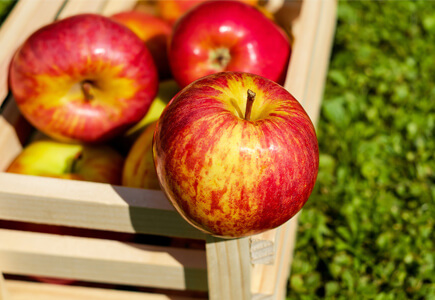
If you’re following a ketogenic diet, apples are just too high in sugar content to be considered for consumption in most cases. Avoid these when possible as they quickly add up in carb counts.
If you just can’t live without apples, try to use them sparingly with small portion sizes. For example in our Apple and Ham Flatbread recipe, we use just a small amount of apple spread out over several servings to provide that sweet and familiar taste.
Carbs in Bananas
Bananas have 25g carbs per 100g serving ( which is the size of an average medium-sized banana), so you should not consider eating them when on a low carb, ketogenic diet.
Even their less-sweet cousin, plantains, contain 30g carbs per serving because of their high starch content.
If you’re a banana lover, however, there is no need to worry. You can still incorporate their distinct flavor in your keto diet.

We’ve used banana extract in a few of our keto recipes and found that it adds a fantastic flavor without any of the carbs. Mix banana extract into low carb bread and smoothie recipes, or add it to ice cream and waffles to bring the taste of the tropics to your treats.
Carbs in Honey
While it’s not a fruit, honey is often referred to as a natural, healthy sweetener. Honey is one of the most nutritionally-dense sweeteners but is packed full of simple sugars like fructose.
As with the other “healthy” sweeteners and fruits that we recommend to avoid on keto, honey can cause negative health effects as well.
Most processed honey also contains added sugars and is usually filtered and pasteurized in a way that eliminates most of its nutritional benefits.
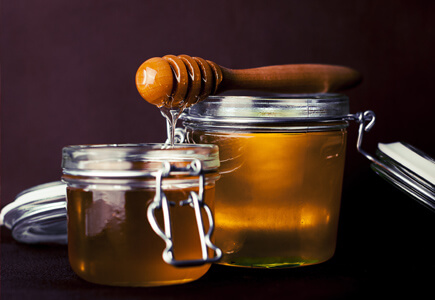
One tablespoon of honey typically contains 17g carbs, which is well over half of our daily allotted amount. Because of this simple fact alone, it is best to avoid all honey consumption on keto.
Fortunately, there are plenty of other ways to sweeten your foods without impairing your progress. To learn more about the best and worst sweeteners to use on a low-carb diet, click here >
Low Carb Fruit Recipes for the Keto Diet
Many of you may be thinking that the ketogenic diet sounds very restricted judging from the fruits we recommend avoiding. While we should always keep an eye on our fruit intake, there are still a plethora of low carb recipes that we can make with fruit.
Below, you’ll find a few examples of our favorite low carb fruit recipes for keto.
Low Carb Smoothies
Smoothies are a great nutrient-dense keto option and are very refreshing in the hotter seasons. They are also so easy and convenient to make that you’ll significantly reduce your meal-prep time. Many people add MCT Oil to give themselves a ketone boost in the morning, but you can customize them a number of ways.
Here are a few examples of low carb smoothies that you can prepare at home:
-
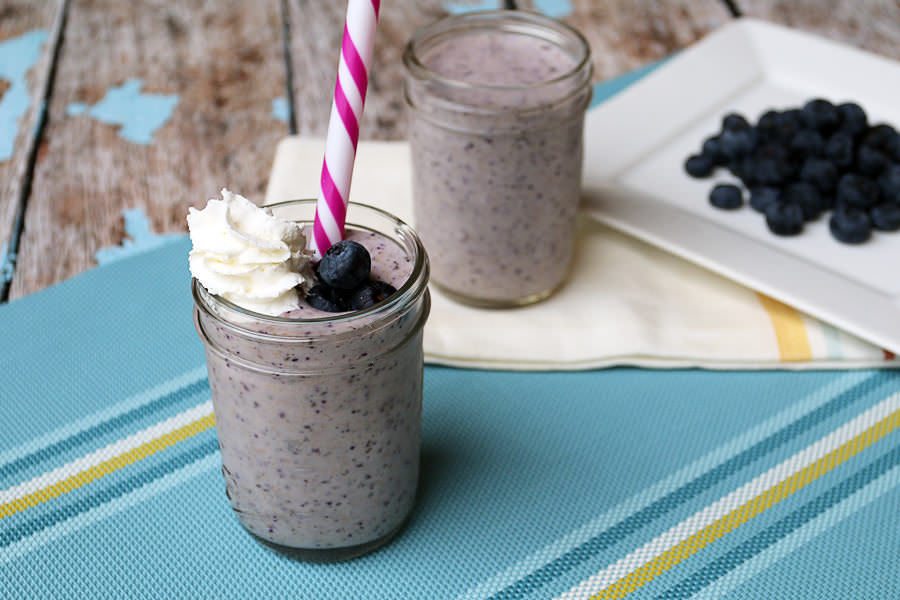
Before you say it, I know what you're thinking: "But Craig, bananas are definitely not allowed on a ketogenic diet!" Don't worry g...
-
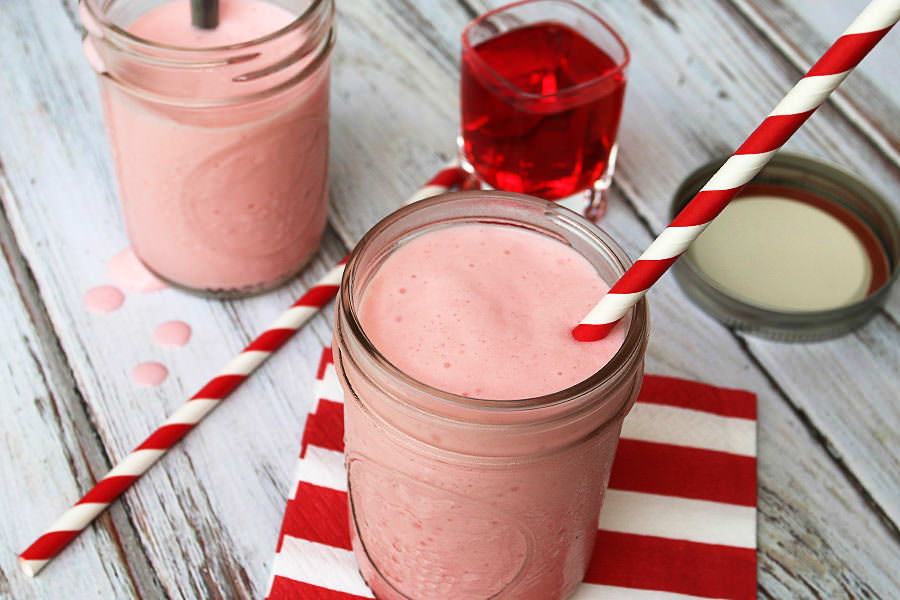
Growing up as a kid, I had my fair share of fast food takeout. Some of them I still miss to this day and try to recreate (a lot of...
-
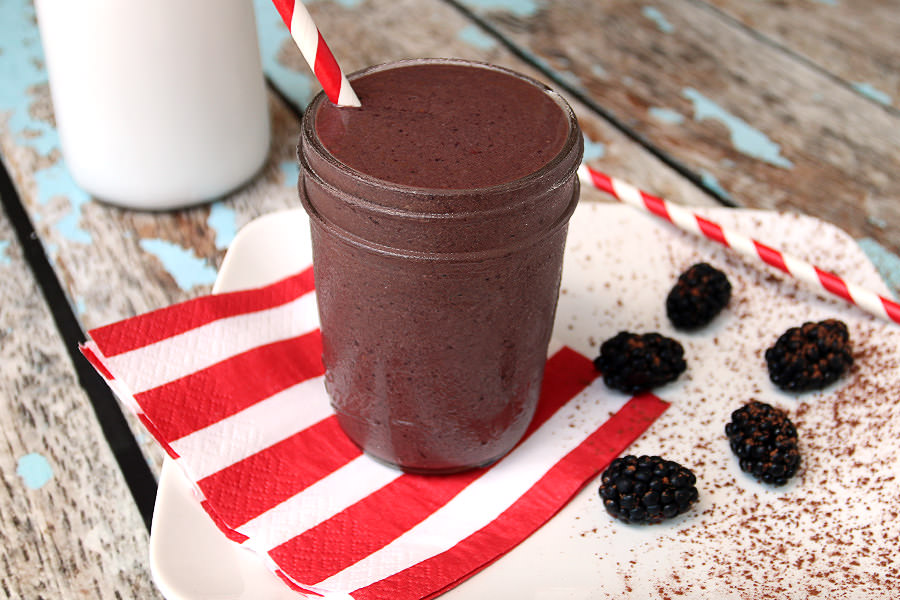
You know those chocolate covered berries you find in those specialty candy stores, or the ones that they serve up to you when you ...
Low Carb Popsicles Using Keto Friendly Fruit
Who said ice pops have to be filled with sugar? All you need is the right mold and keto-friendly ingredients to create a healthy, keto-friendly version of this common childhood favorite. Oh, and don’t forget about the berries!
Here are our two favorite keto fruit popsicles for you to try:
Low Carb Ice Cream
Fruit and ice cream are an amazing combination, but they both tend to come with too much sugar for low-carb diets. Fortunately, with the help of low-carb sweeteners, berries, and fat-rich keto ingredients, we can whip a healthy keto-friendly ice cream that takes like the real thing (without any added sugar).
Take look at these keto ice cream recipes for some inspiration:
Low Carb Jam
Jam doesn’t have to be a thing of the past. You can find low carb fruit preserves in the store (sometimes with added fiber), or you can make your own at home! Spread it on some walnut zucchini bread if you’re craving something a little bit different for breakfast or have it on some keto bread. There are so many different ways you can incorporate it into your keto diet.
Nut butter can be a fantastic source of fat, but sometimes you just want a layer of sweetness to help cut through the richness. Feel free to make some low carb strawberry jam to keep the PB&J cravings at bay or add a little spicy kick to the sweetness with our low carb blackberry chipotle jam.
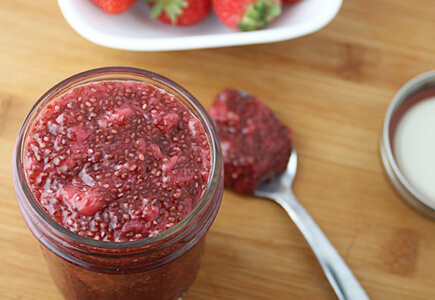
Low Carb Pastries
Fruit can be incorporated in many different types of desserts on a ketogenic diet. From cakes to tarts to donuts, you can recreate many of your old favorites in low-carb fashion.
Some examples of our reader favorite recipes are:
-

Summer is such a treat on keto as the berries are in season and there's so many things to make with them! The weather this year ha...
-

These Lemon Raspberry sweet rolls will help you start off the morning right! The sweet, delicate, layers of dough are slathered wi...
-
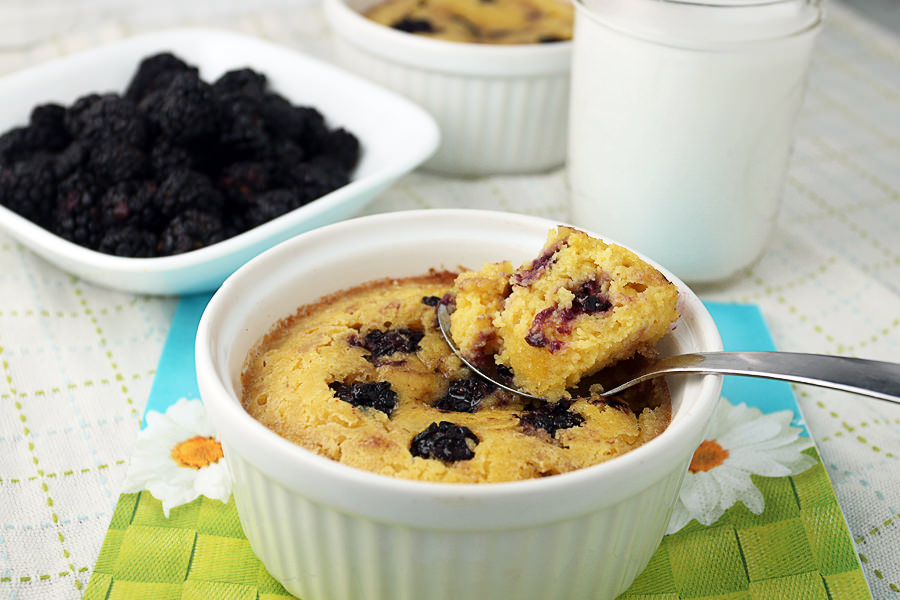
Happy 4th of July everyone! I hope you're sitting back, relaxing, and firing up the grill for a delicious lunch and dinner. Today'...
Keto friendly Fruit, Net Carb Content, and Your Keto Meal Plan
To better illustrate what adding low carb fruits to your keto meal plan can look like, here’s a day of high fat, low carb recipes along with their carb counts per serving:
Breakfast: Low Carb Blueberry Ricotta Pancakes
- 10.8g total carbs
- 5.8g net carbs
Lunch: Blackberry, Basil and Spinach Pressed Halloumi
- 8.9g total carbs
- 5.7g net carbs
Dinner: Blackberry Chipotle Chicken Wings with a Raspberry Pecan Side Salad
- 12g total carbs
- 5.8g net carbs
Dessert: Strawberry Rhubarb Swirl Ice Cream
- 4.3g total carbs
- 3.6g net carbs
Total carb content for the day: 36g
Total net carbs: 20.9g
This one-day keto meal plan example demonstrates that it is possible to incorporate different types of berries into each meal without missing out on the health benefits of ketosis and low carb dieting.
That said, it is also important to notice how quickly the carb counts climb when we use low carb fruits that are higher in sugar. Over time it will likely become too challenging to stay within your keto carb limit while eating berries (and other higher carb foods) with every meal.
An easier strategy is to include fruits in moderation: incorporate only one or two berry-based keto fruit recipes per day and prioritize the lowest carb fruits, such as avocado and tomato. Avocado, in particular, doubles as a high fat & fiber-rich keto-friendly food, which will make it easier for you to control hunger and lose weight.
However, keep in mind that the amount of fruit you can eat on keto varies from person to person. For the most part, this will depend on your overall health, weight loss goals, and macronutrient targets.
How Much Fruit Can You Eat on the Keto Diet?
It is best to think of fruit as a supplement to your keto diet, not as a significant component. Most of your carbs, fat, protein, vitamins, and minerals should be coming from meat, seafood, high-fat dairy, low-carb vegetables, and some nuts/seeds.
By eating in this way, you’ll likely have 5-10 grams of net carbs to spare on a 100-gram serving of the lower carb sweet fruits, such as raspberries, strawberries, starfruit, and watermelon, without preventing ketosis.
That being said, the two lowest carb fruits, avocado and tomato, can be eaten a bit more liberally on keto. Many keto dieters, for example, have added a whole avocado (~200 grams) into their daily diet without any issues.
To learn exactly how much fruit you can eat without slowing your keto progress, use our keto macro calculator. This way, you can customize the serving sizes based on your specific carb limit.
Key Takeaway on Keto Fruits — Low Carb Fruit Intake and the Keto Diet
As a final takeaway, always be cautious when consuming fruit on a ketogenic diet. You must limit your carb intake low enough to enter ketosis, so it’s best to eat low-carb fruits in moderation.
Remember that fruit is essentially nature’s candy. It is filled with high amounts of glucose and fructose, which can decrease ketone production and make it difficult to enter ketosis. To learn more about what you should and shouldn’t eat to enter and sustain ketosis, read through our in-depth keto food list.
